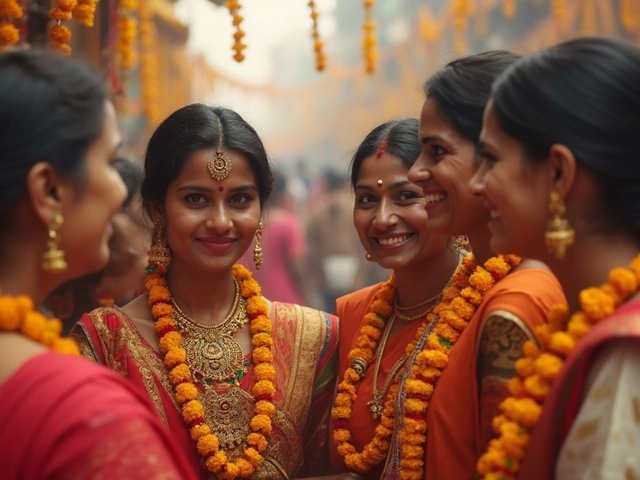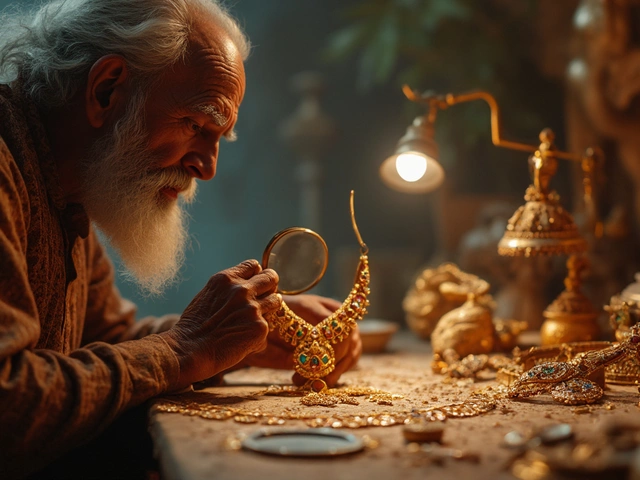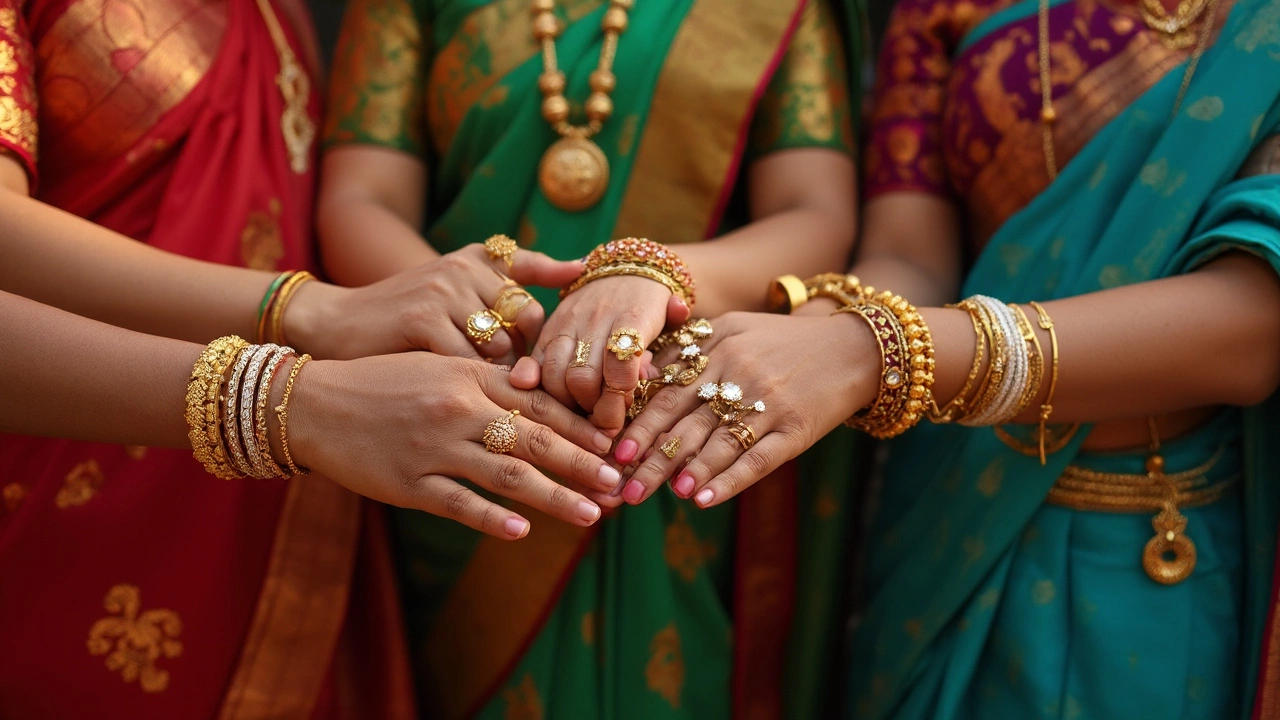
Gold isn’t just gold—walk into any jewelry store and you’ll see yellow, white, and even pinky-colored gold. But have you ever wondered what color gold itself “prefers” to be around? In jewelry design, the colors you pair with gold can actually make a huge difference in how luxe or subtle a piece looks.
If you’re lost when shopping or designing, knowing which shades bring out the best in gold helps a lot. Jewelers have played with this for centuries, always betting on combinations that make gold shine brighter or look more elegant. Simple stuff like whether you put gold next to deep green, classic black, or fresh white can totally change a necklace or ring’s vibe.
- Why Gold Loves Certain Colors
- The Different Shades of Gold in Jewelry
- Colors That Best Compliment Gold
- Picking the Right Gold Color for Your Skin Tone
- Tips for Mixing Gold with Other Jewelry Colors
Why Gold Loves Certain Colors
Gold isn’t shy. It’s bold, shiny, and always grabs your attention. But here’s the thing—gold jewelry looks totally different depending on what color it’s paired with. Designers and style experts have noticed that some colors just make gold look richer and more appealing.
Why? It all comes down to how we see color. Gold has warm, yellow tones, so colors that contrast or complement those tones can change how bright or deep the gold jewelry appears. For example, deep colors like navy, emerald green, or even burgundy make gold pop. These colors are considered ‘jewel tones’ and have been used since ancient times to give gold that extra wow factor. Try putting a gold necklace on a navy shirt, and it’s a whole different story than on a beige top.
It also works the other way. Neutral backgrounds like clean white or subtle black create space for gold to shine without distraction, making it stand out effortlessly. But not every color does gold a favor. Pastels, like soft pinks and light blues, can sometimes make gold look washed out, especially if the gold itself is a lighter hue.
Jewelers also consider skin tone, because gold’s warmth can clash or blend depending on the person. That’s why some people look better in yellow gold, while others can pull off rose or white gold. But most importantly, thinking about what goes with gold helps you pick jewelry that won’t get lost in your outfit or work setting.
Whenever you want your gold jewelry to really stand out, pair it with bold, rich colors or classic neutrals. And if you’re picking gold pieces for gifts or events, think about the clothes or colors most likely to be worn. This little trick makes your choice look intentional, not accidental.
The Different Shades of Gold in Jewelry
You might be surprised how many flavors gold actually comes in. It's not just about the classic yellow – jewelry designers use different mixes of metals to change the vibe. So, let’s break down the most common shades you’ll spot at any good jewelry counter.
Gold jewelry basically comes in three main shades: yellow, white, and rose. Each one gets its color from the other metals it’s mixed with, which is called an alloy. Pure gold (24K) is super yellow, but it's soft and bends way too easily for daily wear. So, most jewelry drops it down to 18K, 14K, or sometimes 10K by mixing in other metals. Here’s how they break down:
- Yellow Gold: This is the OG, the color people think of first. It gets its warmth from a mix of gold, copper, and sometimes a little silver. The higher the karat, the richer the yellow.
- White Gold: Jewelers add metals like nickel, palladium, or manganese to gold to get a cool, silvery look. It often has a rhodium coating to make it extra shiny and white, but over time you might need to re-plate it.
- Rose Gold: This has copper in the mix, which gives it a blush or pinkish color. The more copper, the redder it looks. Rose gold’s become super trendy in the last ten years, especially for rings.
To get a feel for how much gold you’re actually getting in a piece, always look at the karat number. Here’s a quick comparison:
| Karat | Gold Content (%) | Main Shade(s) |
|---|---|---|
| 24K | 99.9% | Bright yellow (too soft for most jewelry) |
| 18K | 75% | Rich yellow, or can be white or rose |
| 14K | 58.3% | Yellow, white, or rose – more durable |
| 10K | 41.7% | Usually used for tough everyday jewelry |
There are some fun spin-offs too. Green gold has silver added for a pale look, and even black gold exists (it’s usually coated or alloyed with special metals). But yellow, white, and rose are the mainstays.
Keep in mind: different cultures have favorites. In India, bright yellow gold is king. Western countries lean toward white and rose for modern styles. So if you’re picking out jewelry or designing a piece, knowing the gold shade isn’t just about color — it actually changes the whole feel and meaning of the piece.
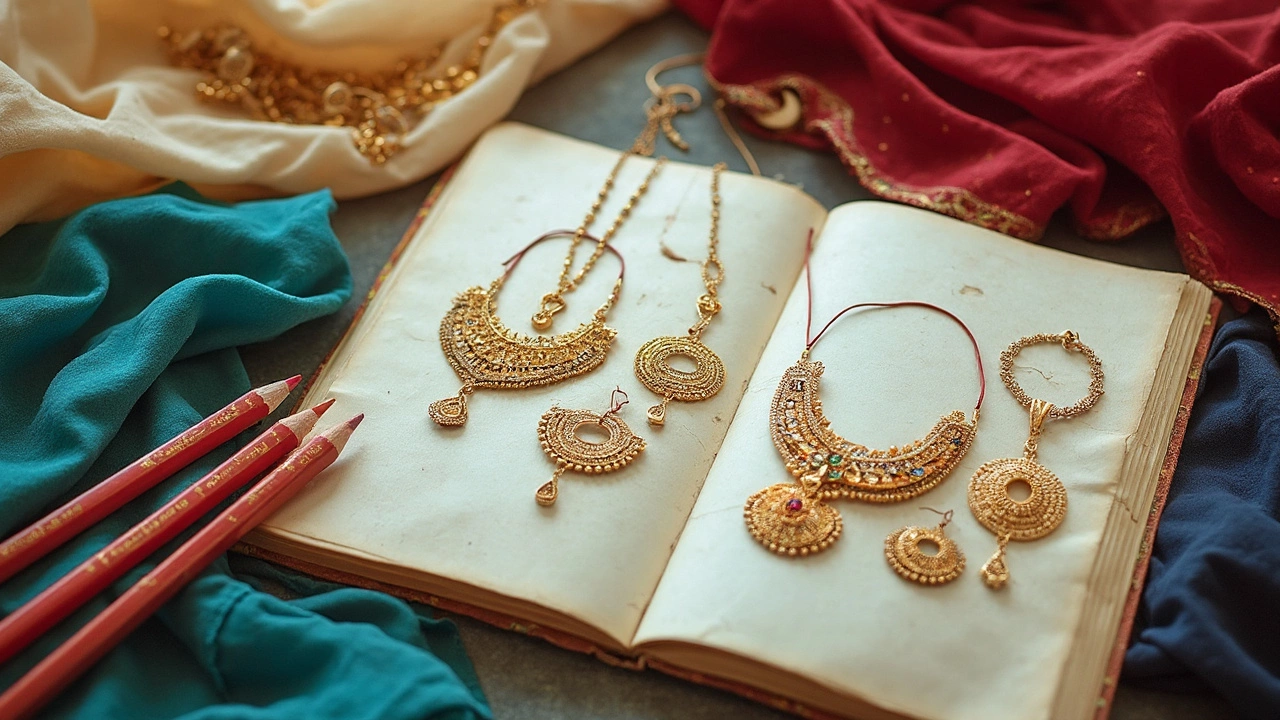
Colors That Best Compliment Gold
Ever notice how some jewelers always pair gold with certain colored gems or outfit pieces? That's not random. Colors can seriously change how your gold jewelry stands out. For example, deep, rich tones usually make gold pop the most. Think bottle green, royal blue, burgundy, and black. These colors help gold look even more expensive and bold.
It’s not just about what looks good, either. Color theory in jewelry is actually backed up by science—opposite or contrasting shades tend to highlight each other. That’s why you’ll almost never see gold right next to yellow, but you’ll see it set into emerald, sapphire, onyx, or even a simple black dress.
- Emerald Green: Probably the most classic. This shade brings out the warmth in yellow gold and gives jewelry a rich, vintage feel.
- Royal Blue: Sapphires or dark blue enamel next to gold? Instant eye-catcher.
- Burgundy/Deep Red: Think rubies or garnet. These shades can make gold look modern and super classy.
- Black and White: Black makes gold shine brighter. White, whether it's enamel or pearls, gives a clean, sharp contrast.
- Purple: Historically, purple (like amethyst) with gold was reserved for royalty. Today, it’s still a combo that looks fancy without trying too hard.
You might be thinking, do these choices really matter? According to a National Jeweler magazine survey from 2023, 72% of customers said they chose gold jewelry set with darker or contrasting colors over plain yellow gold pieces. That tells you people notice when gold and color team up right.
| Color | Effect on Gold | Popular Use in Jewelry |
|---|---|---|
| Emerald Green | Intensifies warmth | Rings, pendants |
| Royal Blue | Makes gold vibrant | Studs, bracelets |
| Burgundy/Red | Adds drama and luxury | Statement necklaces, earrings |
| Black | Sharp contrast, gold glows | Watches, rings |
| White | Clean, modern feel | Pearl sets, accent details |
If you’re choosing a piece or designing your own, stick with these shades and you’ll always have jewelry that stands out. It’s not about following rules, just knowing what works best with gold’s natural shine. Want your gold jewelry to look like it costs a million bucks? It’s all about what color you put next to it.
Picking the Right Gold Color for Your Skin Tone
This is where a lot of people trip up. Not every type of gold looks great on everyone. Choosing the right shade of gold jewelry isn’t just about following trends—it’s about matching it to your skin tone. This is a real game-changer if you want jewelry that truly suits you.
Start by figuring out your skin's undertone. There are three main types: cool, warm, and neutral. Here’s how you can tell which one you are:
- If your veins look bluish, and silver jewelry tends to look better on you, you’ve probably got cool undertones.
- If your veins look greenish, and gold jewelry seems to pop, then you’re likely warm-toned.
- If you can’t really tell, or everything kind of looks good, you’re probably neutral.
So what does this mean for picking gold?
- Yellow gold works best on warm skin tones—it brings out the natural glow and never looks too stark against the skin.
- White gold and even platinum are often better picks for cool undertones. They’re less yellow and tend to blend better with fair or pinkish skin.
- Rose gold is a great middle ground. Its pink tint flatters neutral skin tones, but honestly, it looks good on almost everyone. If you’re stuck, go for rose gold.
If you ever notice that gold jewelry makes you look washed out, try switching the type. Something as simple as going from yellow to white gold can totally change the look. And when in doubt, try on different pieces at the store. Natural light tells you everything you need to know—just hold it up to your wrist or neck and go with what makes your skin look healthy and glowing.
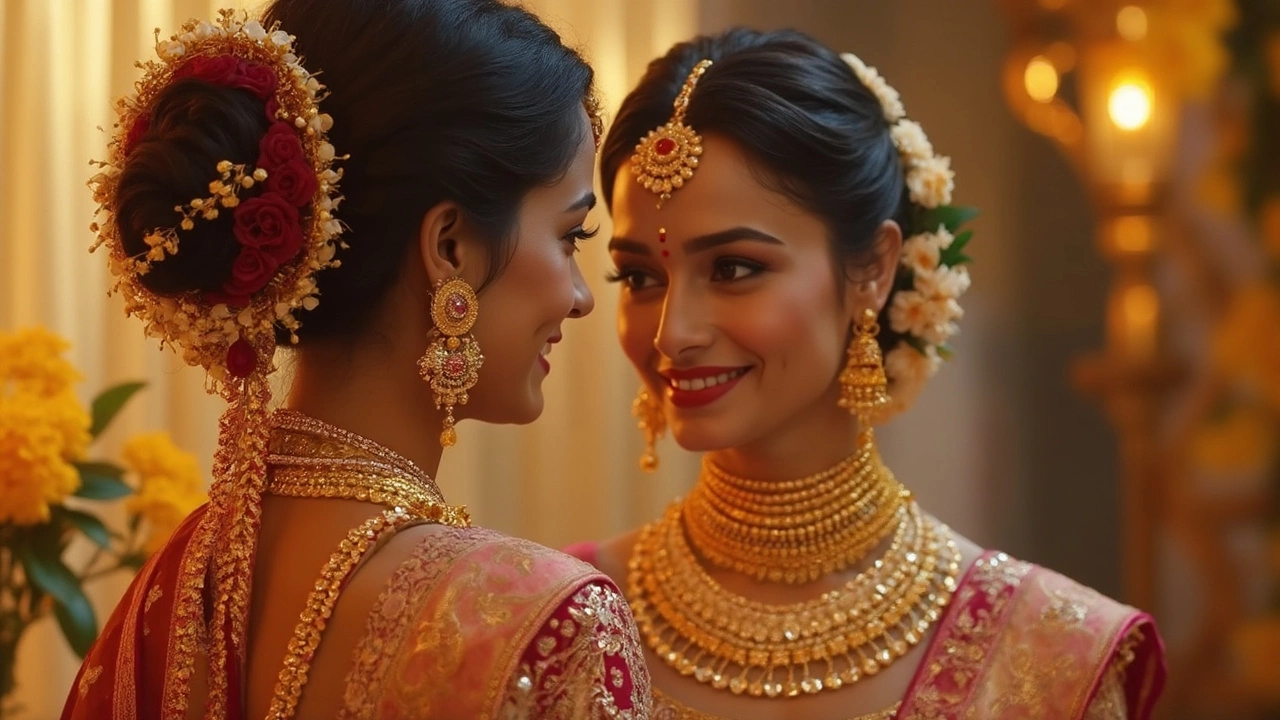
Tips for Mixing Gold with Other Jewelry Colors
If you want your gold jewelry to stand out—not just blend in—mixing it with the right colors is smart. There’s actually a bit of science behind what looks best next to gold. Let’s break it down so you never have to guess again.
First, gold pairs really well with certain metals and gemstones because of how light hits them. Jewelry designers often mix gold jewelry with other metals: think white gold, platinum, or silver for a fresh, modern vibe. Rose gold plus yellow gold is trendy, too, and brings some warmth to your look instead of just sticking with one shade.
Don’t forget gemstones. Deep colors like emerald, navy, or ruby give gold some serious contrast. Soft shades—think pearl or opal—make gold’s shine stand out without competing. On the flip side, orange or bright yellow stones can blend too much, so the gold doesn’t pop as much.
Here are some quick tips for mixing gold with other jewelry colors:
- Stick to two main metal colors at a time—too many can look hectic instead of stylish.
- If you’re layering necklaces, a rule of thumb is to vary the textures and shades of gold so the pieces don’t just blur together.
- When wearing bold, gemstone-heavy pieces, keep other jewelry simpler and close in color tone—like matching a ruby ring with gold hoops, not silver ones.
- The little things matter; gold clasps or chain extenders look sleek when they match your jewelry’s main color instead of standing out awkwardly.
Here’s a quick look at what popular gold mixes people tend to go for, and how often they show up in major jewelry brands’ collections, based on 2024 global sales data:
| Combo | Popularity (%) |
|---|---|
| Yellow Gold + White Gold | 38 |
| Yellow Gold + Rose Gold | 29 |
| Yellow Gold + Platinum | 13 |
| Gold with Colored Gemstones | 20 |
Last thing: trends shift every few years, but yellow gold mixed with white or rose gold is sticking around. If you want to play it safe and always look on point, those combos are a no-brainer. The main goal is to keep your look balanced and let the gold work its magic instead of fighting for attention.

